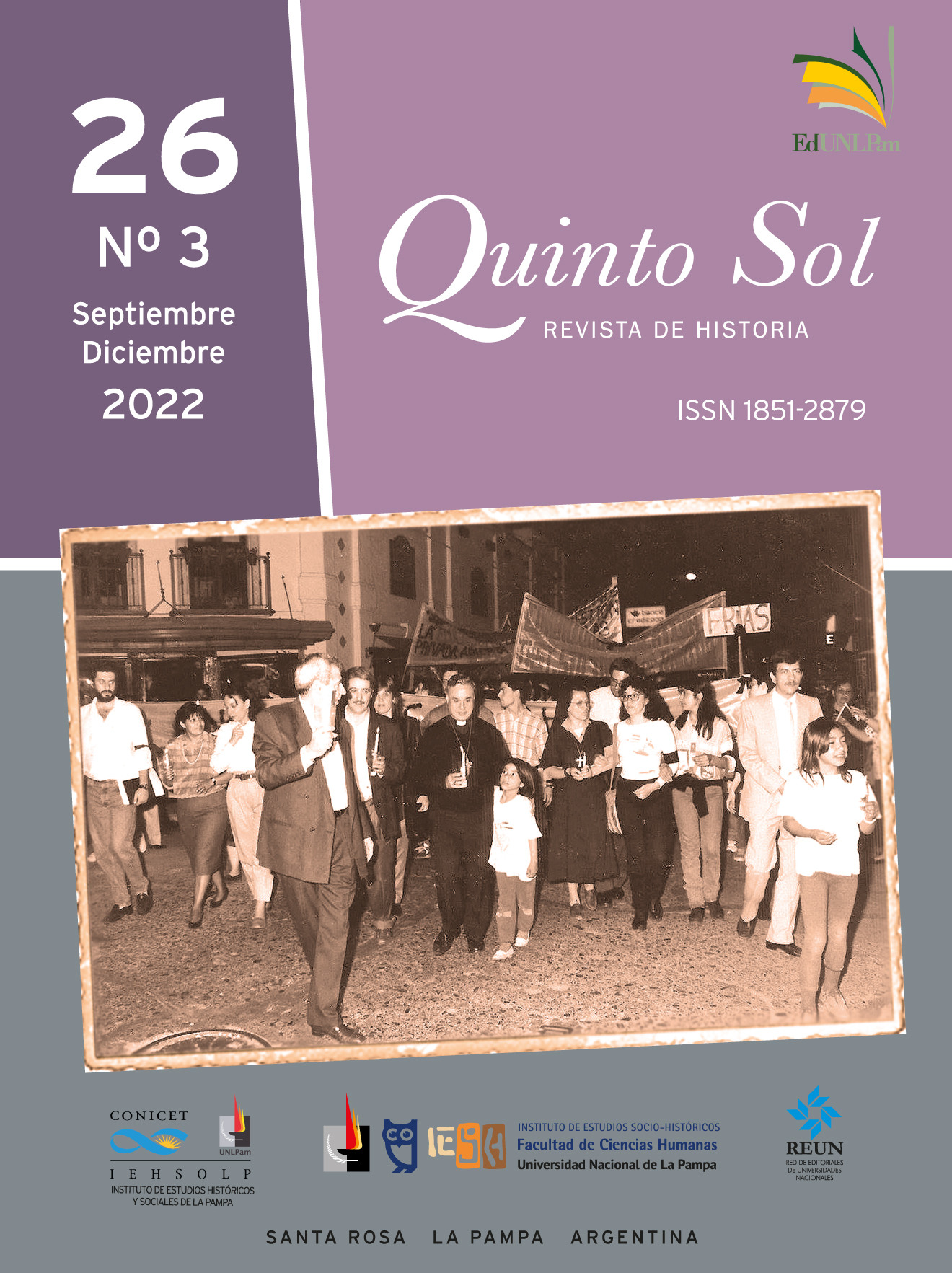Laicity in Jujuy in light of the constitutional reforms, the ecclesiastical reality and the political contexts (1893-1955)
DOI:
https://doi.org/10.19137/qs.v26i3.6893Keywords:
laicity, provincial constitutions, ecclesiastical realityAbstract
The article offers an approach to the issue of laicity in Jujuy, placing the focus in the texts of the five constitutional letters that the province sanctioned between the end of the 19th century and the middle of the 20th, and in the respective constitutional conventions. In addition to referring to the political contexts in which these reforms were inscribed, the central guidelines of the ecclesiastical reality of the northern province are traced throughout the decades considered. The focus is put on some specific events and moments in search for keys to understand the persistence of a peculiar feature of the local political scene, which is the scant gravitation that the Church and its organizations had in it, in strong contrast with the vivid manifestations of popular faith throughout the provincial geography. The rhythms, scope and periodization of the secularization process in Argentina are topics still open to debate and there are several calls to allow for the specificities of scenarios and contexts in each local space, providing the historical analysis with a more solid empirical basis. The lines that follow intend to make a contribution in this sense
Downloads
References
Bidondo, E. (1980). Historia de Jujuy (1535-1950). Plus Ultra.
Bidondo, J. A. (2005). Notas para la historia de la Legislatura jujeña, 1935-1985. Cuadernos del Duende.
Bidondo, J. A., Constant, M. y Lagos, M. (2007). Orientación bibliográfica para la historia de Jujuy. Secretaría de Turismo y Cultura.
Cicarelli, V. (1935). Lo que dije y lo que iba a decir (en la Convención Reformadora de la Constitución). Imprenta San Francisco.
Conti, V. (2006). De las guerras de la Independencia a la organización del Estado. En A. Teruel y M. Lagos (Dirs.) Jujuy en la Historia. De la Colonia al Siglo XX (pp. 85-137). Editorial de la Universidad Nacional de Jujuy.
Di Stefano, R. (2011a). Por una historia de la secularización y de la laicidad en la Argentina. Quinto Sol, 15 (1), 1-32. http://www.fchst.unlpam.edu.ar /ojs/index.php/quintosol
Di Stefano, R. (2011b). El pacto laico argentino (1880-1920). PolHis, 8 (2), 80-89. http://historiapolitica.com/datos/boletin/PolHis_8.pdf
Di Stefano, R. y Zanca, J. (2016). Fronteras disputadas: religión, secularización y anticlericalismo en la Argentina (siglos XIX y XX). Imago Mundi.
Gallo, E. (2008). Vida, libertad, propiedad: Reflexiones en torno al liberalismo clásico y la historia. Editorial de la Universidad Nacional de Tres de Febrero.
Gobierno de Jujuy (1893). Constitución de la Provincia de Jujuy. Imprenta Europea, Moreno y Defensa.
Kindgard, A. (2003). Ruptura partidaria, continuidad política. Los "tempranos" orígenes del peronismo jujeño. En D. Macor y C. Tcach (Eds.) La Invención del Peronismo en el Interior del país (pp. 163-212). Universidad Nacional del Litoral.
Lattuada, M. (1987). Política agraria del liberalismo-conservador, 1946-1985. Centro Editor de América Latina.
Legislatura de Jujuy (1888). Ley de Educación Común. Imprenta tipográfica de José Petruzzelli.
Legislatura de Jujuy (1935). Constitución de la Provincia de Jujuy según la Reforma de 1935. Imprenta del Estado.
Legislatura de Jujuy (1949). Constitución de la Provincia de Jujuy promulgada el 1° de mayo de 1949. Imprenta del Estado.
Mauro, D. (2014). Procesos de laicización en Santa Fe (Argentina): 1860-1900. Consideraciones sobre la «Argentina liberal y laica». Revista de Indias, 261 (LXXIV), 539-560. http://dx.doi.org/10.3989/revindias.2014.018
Ovejero, D. (1942). El terruño (vida jujeña). Kraft.
Paz, G. (2006). La provincia en la nación, la nación en la provincia. 1853-1918. En A. Teruel y M. Lagos (Dirs.) Jujuy en la Historia. De la Colonia al Siglo XX (pp. 139-183). Editorial de la Universidad Nacional de Jujuy.
Pistoia, B. (1986). Los franciscanos en San Salvador de Jujuy. Su presencia y su obra. Mimeo.
Tcach, C. (1991). Sabattinismo y peronismo. Sudamericana.
Tommasini, G. (1934). El Convento de San Francisco de Jujuy. Revista de la Universidad Nacional de Córdoba, 21 (1-2), 9-90.
Vergara, M. A. (1927). Reseña Histórica del Colegio de Dolores. En Colegio del Huerto (Ed.) Recuerdos y Homenaje a las Hermanas del Huerto (pp. 5-17). Imprenta Parroquial.
Villafañe, J. (1951). Monseñor José de la Iglesia. Ministerio de Gobierno.
Yépez, D. (2003). La mano avara y el Cristo caído. Alción.
Downloads
Published
Issue
Section
License
When submitting their contributions, authors must declare that they have the permission of the file or repository where the documents that are attached to the work were obtained, whatever their format (unpublished manuscripts, images, audiovisual files, etc.). Such permission authorizes their publication and reproduction, releasing the journal and its editors from any liability or claim from third parties.
Likewise, authors must adhere to the Creative Commons license called "Attribution - Non-Commercial CC BY-NC-SA", through which the author allows copying, reproducing, distributing, publicly communicating the work and generating derivative works, as long as the original author is properly quoted and acknowledged. It is not allowed, however, to use the work for commercial purposes. Authors may establish additional agreements for the non-exclusive distribution of the version of the paper published in the journal (for example, placing it in an institutional repository or publishing it in a book), with the acknowledgment of having been published first in this journal.
The publication of content in this journal does not imply any royalty or charge for taxpayers.
Quinto Sol adheres to the DORA (Declaration on Research Assessment) signed in San Francisco, California, on December 16, 2012, and to the Declaration of Mexico (Joint Declaration LATINDEX - REDALYC - CLACSO - IBICT).










4.png)
2.png)












_(2).png)


1.jpg)



1.jpg)





